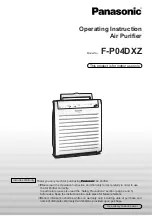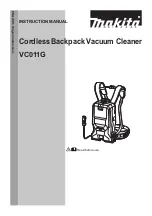
21
EngLIsh
3. Follow the direction under
connecting to Power Tools
to
connect to the power tool to be used.
nOTE:
If the tool control switch is turned on, and no power
cord is plugged into the outlet
12
, the vacuum will turn on
briefly and then off again to indicate the tool control switch
13
is in the on position.
Connecting to Power tools (Fig. A, D, E)
WARNING:
Only use the outlet
12
for purposes specified
in the instructions.
1. Plug the vacuum power cord into an appropriate outlet.
2. Plug the power tool into the outlet
12
.
nOTE:
See
Power connection data of power tool
under
Technical Data
for the power allowance of the tool to be
plugged into the outlet
12
.
3. Turn tool control switch
13
to the ACTIVATION position
. This allows the vacuum to be turned on and off
automatically by the power tool.
nOTE:
The vacuum cleaner starts automatically within
0.5 seconds and continues to run for 15 seconds after the
power tool has been turned off.
4. To switch back to manual mode, turn the tool control
switch
13
off. In manual mode the tool and the vacuum are
turned on and off independently of each other.
5. Your
D
e
WALT
construction dust extractor is fitted with the
D
e
WALT
AirLock connection system. The AirLock allows for
a fast, secure connection between the suction hose
7
and
power tool. The AirLock connector
16
connects directly to
D
e
WALT
compatible tools or through the use of an AirLock
adapter (available from your local
D
e
WALT
supplier). Refer to
the
Accessories
section for detail on available adapters.
nOTE:
If using an adapter ensure it is firmly attached to the
tool outlet before following the steps below.
a. Ensure the collar on the AirLock connector is in the
unlock position. Align notches
17
on collar and AirLock
connector as shown for unlock and lock positions.
b. Push the AirLock connector onto the adapter
connector point.
c. Rotate the collar to the locked position.
nOTE:
The ball bearings inside collar lock into slot and
secure the connection. The power tool is now securely
connected to the dust extractor.
Automatic Filter Cleaning System
This vacuum has a highly effective filter cleaning system
which minimizes filter clogging. Every 30 seconds, one of the
two filters gets automatically cleaned. The cleaning process
alternates between the filters and continues through the life of
the unit.
nOTE:
It is normal to hear a clicking sound during this process.
nOTE:
After many hours of operation the automatic filter
cleaning system may not be effective. When this happens the
filters will need to be cleaned or replaced. Refer to
Filter
under
MAINTENANCE.
Parking Brake (Fig. A, F)
The parking brake will lock one wheel in place to prevent
vacuum from rolling.
1. To engage parking brake, push down on the 'ON' side of
the brake.
2. To disengage parking brake, push down on the 'OFF' side
of the brake.
Remove / Change Used Dust Collection
Bag (Fig. A)
WARNING:
Appropriate personal protective equipment
like dust mask and gloves should be used while handling
used dust bags.
1. Turn off vacuum and unplug cord from outlet.
2. Unlatch canister latches
5
and remove vacuum head
4
.
3. Pull the collection bag carefully from inlet
10
.
4. Seal the collection bag opening tightly when removing it
from the machine.
5. Dispose of collection bag in appropriate container according
to statutory provisions.
Wet Pick Up Applications (Fig. A, G)
WARNING:
DO NOT connect power tools to outlet
12
when using the vacuum for wet pick up.
WARNING:
Plug vacuum into residual current device
(RCD) protected outlet when using the vacuum for wet
pick up.
WARNING:
If foam or liquid escapes from the machine,
switch off immediately.
CAUTION:
Clean the water level limiting device regularly
and examine it for signs of damage. Refer to Fig. G.
NOTICE:
DO NOT remove ball float
19
, doing so will
cause damage to the vacuum. The ball float keeps water
from entering the motor.
Before using the vacuum for wet pick up:
• Ensure the canister is empty and free of excessive dust.
• Remove filters
9
.
• Plug vacuum into a RCD protected outlet.
WARNING:
Do not use the machine with this set up for
dust Class L.
To Empty Canister (Fig. A, G)
The ball float valve
19
will block air to the motor when the
canister is full and the sound of the motor will change at once.
When the motor has a high pitched sound and air/water flow
stops, empty the canister.
1. Turn off vacuum and unplug cord from outlet.
2. Unlatch canister latches
5
and remove vacuum head
4
.
3. Empty contents of canister
6
into a suitable container
or drain.
















































